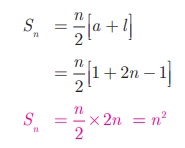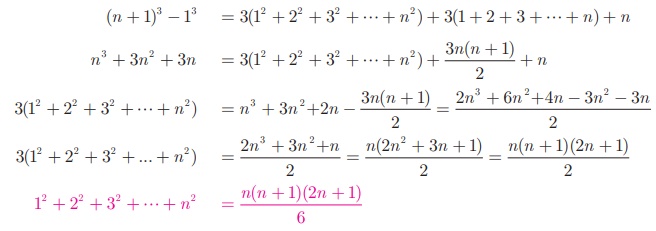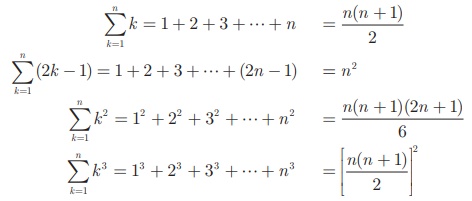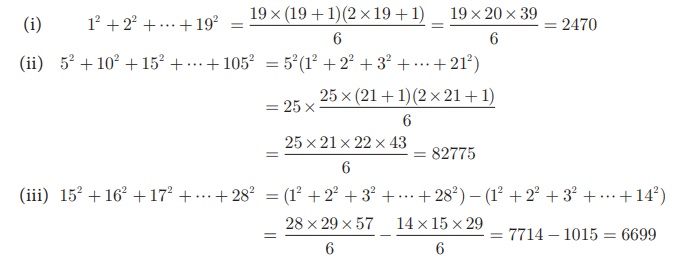Definition, Theorem, Example, Solution | Mathematics - Special Series | 10th Mathematics : UNIT 2 : Numbers and Sequences
Chapter: 10th Mathematics : UNIT 2 : Numbers and Sequences
Special Series
Special
Series
There are some series
whose sum can be expressed by explicit formulae. Such series are called special series.
Here we study some
common special series like
(i) Sum of first ‘n’
natural numbers
(ii) Sum of first ‘n’
odd natural numbers.
(iii) Sum of squares of
first ‘n’ natural numbers.
(iv) Sum of cubes of
first ‘n’ natural numbers.
We can derive the
formula for sum of any powers of first n natural numbers using the
expression (x + 1)k +1 − x k
+1 . That is to find 1k + 2k + 3k
+ ... + nk we can use the expression (x + 1)k
+1 − x k +1 .
1. Sum of first n natural numbers
To find1 + 2 + 3 + + n
, let us consider the identity (x + 1)2 − x 2
= 2x + 1
When x = 1 , 22
− 12 = 2(1) + 1
When x = 2 , 32
− 22 = 2(2) + 1
When x = 3 , 42
− 32 = 2(3) + 1
: :
:
When x = n
−1 , n 2 − (n −1)2 = 2(n −1) + 1
When x = n
−1 , (n + 1)2 - n
2= 2(n) + 1
Adding all these
equations and cancelling the terms on the Left Hand side, we get,
(n
+ 1)2 −12 = 2(1 + 2 + 3 + + n ) + n
n
2
+ 2n= 2(1 + 2 + 3 + + n ) + n
2(1 + 2 + 3 + + n) = n 2 + n = n (n + 1)
1 + 2 + 3 + + n= [n (n
+ 1)] / 2

2. Sum of first n odd natural numbers
1 + 3 + 5 + + (2n
−1)
It is an A.P. with a
= 1 , d = 2 and l = 2n −1

3. Sum of squares of first n natural numbers
To find12 + 22
+ 32 + + n2 , let us consider the identity (x
+ 1)3 − x 3 = 3x 2 +
3x + 1
When x = 1 , 2 3
− 13 = 3(1)2 + 3(1) + 1
When x = 2 , 3 3
− 2 3 = 3(2)2 + 3(2) + 1
When x = 3 , 4 3
− 3 3 = 3(3)2 + 3(3) + 1
: : :
When x = n
−1 , n 3 − (n −1)3 = 3(n −1)2
+ 3(n −1) + 1
When x = n
, (n + 1)3 −n3 = 3n 2 + 3n
+ 1
Adding all these
equations and cancelling the terms on the Left Hand side, we get,

4. Sum of cubes of first n natural numbers
To find 13 +
23 + 33 + + n3 , let us consider the
identity
(x + 1)4
− x 4 = 4x 3 + 6x 2
+ 4x + 1
When x = 1 , 2 4
− 14 = 4(1)2 + 4(1) + 1
When x =2 , 34
− 2 4 = 4(2)3 + 4(2) + 1
When x = 3 , 44
− 3 4 = 4(3)3 + 6(3) + 1
: : :
When x = n
−1 ,n4 − (n −1)4 = 4(n −1)3
+ 4(n −1) + 1
When x = n
, (n + 1)4 −n4 = 4n3
+ 6n2 + 4n + 1
Adding all these
equations and cancelling the terms on the Left Hand side, we get,
(n+1)4–14
= 4(13 + 23 + 3 3 + + n 3
) + 6(12 + 22 + 32 + + n2
) + 4(1 + 2 + 3 + + n ) + n
n4 + 4n3
+ 6n2 + 4n = 4(13
+ 23 + 3 3 + + n 3 ) + 6 × 
4(13 + 23
+ 33 + … + n3 ) = n4
+ 4n3 + 6n 2 +4n − 2n3
−n2 − 2n2 − n − 2n2
− 2n –n
4(13 + 23
+ 33 + … + n3 ) = n4
+ 2n3 + n 2 = n2 (n2
+ 2n +1) = n2(n+1)2

Ideal Friendship
Consider the numbers
220 and 284.
Sum of the divisors of
220 (excluding 220) = 1+2+4+5+10+11+20+22+44+55+110=284
Sum of the divisors of
284 (excluding 284) =1+2+4+71+142=220.
Thus, sum of divisors
of one number excluding itself is the other. Such pair of numbers is called Amicable Numbers or Friendly Numbers.
220 and 284 are least
pair of Amicable Numbers. They were discovered by Pythagoras. We now know more
than 12 million amicable pair of Numbers.
Think Corner: 1. How many squares are
there in a standard chess board? 2. How many rectangles are there in a standard
chess board?
Here is a summary of
list of some useful summation formulas which we discussed.
These formulas are used
in solving summation problems with finite terms.

Example 2.54
Find the value of (i) 1 + 2 + 3 + ... + 50 (ii) 16 + 17 + 18 + ... + 75
Solution
(i) 1+ 2 + 3 + + 50
Using, 1 + 2 + 3 +
+ n = 
1+ 2 + 3 + + 50 = 
(ii) 16 + 17 + 18 + +
75 = (1 + 2 + 3 + + 75) −(1 + 2 +
3 + + 15)
=75(75 + 1)/2 −
15(15 + 1) / 2
=2850 −120 = 2730
Example 2.55
Find the sum of
(i) 1 + 3 + 5 + … +
to 40 terms
(ii) 2 + 4 + 6 + …
+ 80
(iii) 1+3 + 5 + … +
55
Solution
(i) 1+3 + 5 +… 40 terms = 402 =
1600
(ii) 2 + 4 + 6 + … + 80
= 2(1 + 2 + 3 + … + 40) = 2 × [40 × (40 + 1)]/2 = 1640
(iii) 1 + 3 + 5 + …
+ 55
Here the number of terms
is not given. Now we have to find the number of terms using the
formula, n = (l-a)/d + 1 gives n= [(55-1)/2] + 1 = 28
Therefore, 1 + 3 + 5
+ + 55 = (28)2 = 784
Example 2.56
Find the sum
of
(i) 12 + 22
+ + 192
(ii) 52 + 1 02
+ 152 + + 1052
(iii) 152 +
162 + 17 2 + + 282
Solution

Example 2.57
Find the sum of (i) 13
+ 23 + 33 + + 163 (ii) 93 +
103 + + 213
Solution

Example 2.58 If 1 + 2 + 3 + … + n = 666 then find n.
Solution
Since, 1 + 2 + 3 + ... + n =  , we have
, we have  = 666
= 666
n 2 + n −1332 =
0 gives (n + 37 )(n − 36)
= 0
So, n = −37 or n
= 36
But n ≠ −37
(Since n is a natural number);
Hence n = 36.
Progress Check
Say
True or False. Justify them.
·
The sum of first n odd natural numbers
is always an odd number.
·
The sum of consecutive even numbers is always
an even number.
·
The difference between the sum of squares of
first n natural numbers and the sum of first n natural numbers is
always divisible by 2.
·
The sum of cubes of the first n natural
numbers is always a square number.
Related Topics